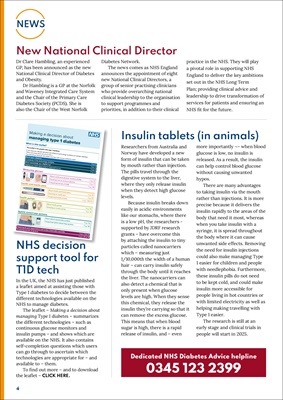
4
NEWS
New National Clinical Director
Dr Clare Hambling, an experienced
GP, has been announced as the new
National Clinical Director of Diabetes
and Obesity.
Dr Hambling is a GP at the Norfolk
and Waveney Integrated Care System
and the Chair of the Primary Care
Diabetes Society (PCDS). She is
also the Chair of the West Norfolk
Diabetes Network.
The news comes as NHS England
announces the appointment of eight
new National Clinical Directors, a
group of senior practising clinicians
who provide overarching national
clinical leadership to the organisation
to support programmes and
priorities, in addition to their clinical
practice in the NHS. They will play
a pivotal role in supporting NHS
England to deliver the key ambitions
set out in the NHS Long Term
Plan; providing clinical advice and
leadership to drive transformation of
services for patients and ensuring an
NHS fit for the future.
NHS decision
support tool for
T1D tech
In the UK, the NHS has just published
a leaflet aimed at assisting those with
Type 1 diabetes to decide between the
different technologies available on the
NHS to manage diabetes.
The leaflet - Making a decision about
managing Type 1 diabetes - summarizes
the different technologies - such as
continuous glucose monitors and
insulin pumps - and shows which are
available on the NHS. It also contains
self-completion questions which users
can go through to ascertain which
technologies are appropriate for - and
available to - them.
To find out more - and to download
the leaflet - CLICK HERE.
What is this leaflet?
This leaflet is for people with type 1 diabetes.
It can help you decide between the different technology available to manage diabetes.
There are some parts for you to fill in.
You should go through this leaflet and then talk to your diabetes team.
Making a decision about
managing type 1 diabetes
Comparing brands of CGM Page 15
Choosing how to measure glucose Page 7
About continuous glucose monitors (CGM) Page 6
Comparing brands of pens Pages 16 & 17
Choosing an insulin pen Page 9
About insulin and insulin pens Page 8
Choosing an insulin pump Page 11
About insulin pumps Page 10
About hybrid closed loop systems Page 12
Comparing hybrid closed loop systems Page 18
Measuring glucose
Insulin and insulin pens
Insulin pumps
Hybrid closed loop systems
About type 1 diabetes Page 2
Preparing for your appointment and further information and links Pages 13 & 14
21
18
15
12
9
6
3
0 6.2mmol/L
250
200
150
100
50
12
0
2
1
0
2
1 0
2
1
Bolus
More actions
Temp basal
My records
Settings
Suspend
5.121
18
15
12
9
6
3
0
mmol/L
09.22
Basal
Active insulin 1.3 u
Bolus5.1 mgdL
BG
09.22
Basal
Active insulin 1.3 u
Bolus5.1 mgdL
BG
A summary of the technology available Page 3
Comparing brands of devices Pages 15 to 18
Which technology am I eligible for? Page 4
Helping you think about what is important to you Page 5
Insulin tablets (in animals)
Researchers from Australia and
Norway have developed a new
form of insulin that can be taken
by mouth rather than injection.
The pills travel through the
digestive system to the liver,
where they only release insulin
when they detect high glucose
levels.
Because insulin breaks down
easily in acidic environments
like our stomachs, where there
is a low pH, the researchers -
supported by JDRF research
grants - have overcome this
by attaching the insulin to tiny
particles called nanocarriers
which - measuring just
1/10,000th the width of a human
hair - can carry insulin safely
through the body until it reaches
the liver. The nanocarriers can
also detect a chemical that is
only present when glucose
levels are high. When they sense
this chemical, they release the
insulin they're carrying so that it
can remove the excess glucose.
This means that when blood
sugar is high, there is a rapid
release of insulin, and - even
more importantly ¬- when blood
glucose is low, no insulin is
released. As a result, the insulin
can help control blood glucose
without causing unwanted
hypos.
There are many advantages
to taking insulin via the mouth
rather than injections. It is more
precise because it delivers the
insulin rapidly to the areas of the
body that need it most, whereas
when you take insulin with a
syringe, it is spread throughout
the body where it can cause
unwanted side effects. Removing
the need for insulin injections
could also make managing Type
1 easier for children and people
with needlephobia. Furthermore,
these insulin pills do not need
to be kept cold, and could make
insulin more accessible for
people living in hot countries or
with limited electricity as well as
helping making travelling with
Type 1 easier.
The research is still at an
early stage and clinical trials in
people will start in 2025.
Dedicated NHS Diabetes Advice helpline
0345 123 2399